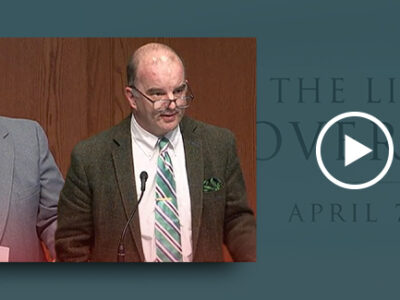It has been quite a week, month and year for the recognition of rights for people identifying as gay. Beginning with the summer’s Lawrence v. Texas U.S. Supreme Court case overturning sodomy laws, the nation’s headlines have been dominated by all things gay up to the present. The “love that dare not speak its name” now won’t simmer down for a moment.
Now that the nation is on the brink of the first state sanctioned gay marriages in Massachusetts, San Francisco and who knows where next, it’s worth asking: How did we get here? And where should we go next?
Having focused on sexuality research over the past several years, I have some thoughts about the matter. While many factors are involved, I believe two broad concepts originating within the professional mental health establishment have brought us to major societal redefinition. What are the broad ideas? First is that homosexuality is a fixed, inborn trait and the second is that children raised by gays are no different than those raised by straights.
In short, I believe the professional mental health establishment has led the way and the courts, legislatures and public opinion have mainly followed. Did I get that backwards? I don’t think so.
After removing homosexuality from its list of disorders in 1973, the American Psychiatric Association and most non-medical counterparts (psychologists, counselors, social workers, etc.) pursued a course of normalizing homosexuality. However, while the mental health establishment once considered gays different from straights because gays were “abnormal,” the new paradigm casts gays as an oppressed minority group. The concept of sexual orientation was invented and strongly promoted as an explanation for sexual variation.
Why do some Adams prefer Steves instead of Eves? Because their hard wired, inborn sexual orientation obliges them to love that way. This theory, still unproven and quite controversial in scientific circles, had clear impact on both the U.S. Supreme Court rationale to strike down the nation’s sodomy laws and the Massachusetts Supreme Judicial Court’s reasoning in creating a marriage right for gay couples. Without the conventional wisdom of gays as a distinct of class of people, we simply wouldn’t be discussing gay marriage as a civil right today.
Another cause often championed by mental health groups is gay parenting. The essential argument advanced by the mental health establishment is that children raised by single gender couples are in no way different or disadvantaged over children raised by opposite sex couples.
The “no difference” belief has been instrumental in removing barriers to gay adoption. Many states have few limitations on adoptions by gays singles or couples. Vermont is a case in point. Prior to Vermont’s Supreme Court mandating civil unions in 1999, the Vermont legislature removed all barriers to gay adoption in 1996. In the opinion leading to civil unions, Vermont’s Supreme Court dismissed the state’s interest in preserving only heterosexual marriage as a means of “furthering the link between procreation and child rearing” because the state already allowed gay couples become parents through adoption and artificial insemination. Based on questionable research from advocates of gay parenting, states began removing barriers to gay adoption at a time when gay marriage was only a talking point for future political action.
A quick read of the book, No Basis, by Robert Lerner and Althea Nagai should convince even the most skeptical reader that we don’t know very much about the actual impact of gay parenting on children.
These are the two broad issues that the major court cases have turned to in order to find a right to marriage for same sex couples. When San Francisco mayor Newsom invokes the equal protection clause of the California constitution, these two ideas are the intellectual foundations for his legal argument. To wit: if gays are obliged by biology to be gay and if the state already recognizes gays as legal parents, then to keep them from marriage is to deprive them of equal protection under the law. Both ideas are quite controversial as a matter of theory but the tentative nature of the fact pattern has not troubled the major mental health organizations. In my view, nearly all of these groups have abdicated their objective role as professional bodies and become lobbying associations.
To say we can anticipate no negative societal consequences of widespread gay marriage based on current social science research borders on professional malpractice. Before we go any further toward the altar, it is time for jurists and legislators at all levels to be more critical consumers of social science research and related policy pronouncements coming from the mental health establishment.



